
The Red Poll is a dual-purpose breed of cattle developed in England in the latter half of the 19th century. The Red Poll is a cross of the Norfolk Red beef cattle and Suffolk Dun dairy cattle breeds.
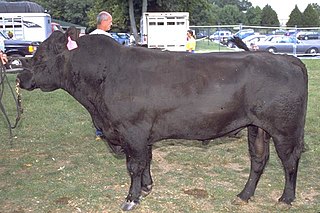
The Aberdeen Angus, sometimes simply Angus, is a Scottish breed of small beef cattle. It derives from cattle native to the counties of Aberdeen, Banff, Kincardine and Forfar in north-eastern Scotland.

Holstein Friesians are a breed of dairy cattle originating from the Dutch provinces of North Holland and Friesland, and Schleswig-Holstein in Northern Germany. They are known as the world's highest-production dairy animals.

The Brahman is an American breed of zebuine-taurine hybrid beef cattle. It was bred in the United States from 1885 from cattle originating in India, imported at various times from the United Kingdom, from India and from Brazil. These were mainly Gir, Guzerá and Nelore stock, with some Indu-Brasil, Krishna Valley and Ongole. The Brahman has a high tolerance of heat, sunlight and humidity, and good resistance to parasites. It has been exported to many countries, particularly in the tropics; in Australia it is the most numerous breed of cattle. It has been used in the creation of numerous taurine-indicine hybrids, some of which – such as the Brangus and Brahmousin – are established as separate breeds.

The Red Angus is a breed of reddish-brown-coloured beef cattle. It derives from the population of Aberdeen Angus cattle and, apart from the coat colour, is identical to it. Red Angus are registered separately from black Angus cattle in Australia, Canada, and the United States.

Wagyu is any of the four Japanese breeds of beef cattle.
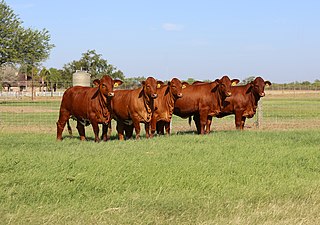
Beefmaster is a breed of beef cattle that was developed in the early 1930s by Tom Lasater, from a systematic crossing of Hereford cows and Shorthorn cows with Brahman bulls. The exact mixture of the foundation cattle is unknown, but is thought to be about 25% Hereford, 25% Milking Shorthorn and 50% Brahman. It was first recognized by the USDA as a new breed in 1954. The original intention was to produce cattle that could produce economically in the difficult environment of South Texas. The cattle were selected by using the Six Essentials – weight, conformation, milking ability, fertility, hardiness and disposition. While brownish-red is the most common color, the breed has no color standards. Over the past decade, the Beefmaster breed has become very popular among herd managers using the breed in their heterosis programs for hybrid vigor. These cattle are a versatile breed and adapt to many climates.
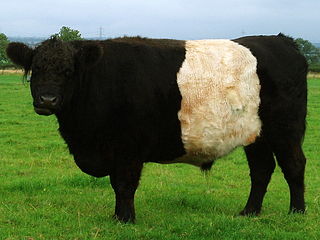
The Belted Galloway is a traditional Scottish breed of beef cattle. It derives from the Galloway cattle of the Galloway region of south-western Scotland, and was established as a separate breed in 1921. It is adapted to living on the poor upland pastures and windswept moorlands of the region. The exact origin of the breed is unclear, although the white belt for which they are named – and which distinguishes the breed from the native black Galloway cattle – is often surmised to be the result of cross-breeding with the similarly-coloured Dutch Lakenvelder breed.

The Senepol breed of beef cattle was developed on the Caribbean Island of St. Croix. It has long been thought that Senepol originated from crosses between N'Dama cattle, imported in the late 19th century, and Red Poll cattle, but it is actually an admixed breed between a European taurina and zebu. The Senepol breed combines characteristics of heat tolerance and insect resistance with the docile nature, good meat, and high milk production of the Red Poll. They are polled, short haired, and colored red, black or brown.
Brangus is a hardy and popular breed of beef cattle, a cross between an Angus and a Brahman. Animals eligible for registration as Brangus cattle are 5/8 Angus and 3/8 Brahman. Brangus is a registered trademark of the International Brangus Breeders Association (IBBA).

The Limousin, French: Limousine, is a French breed of beef cattle from the Limousin and Marche regions of France. It was formerly used mainly as a draught animal, but in modern times is reared for beef. A herd book was established in France in 1886. With the mechanisation of agriculture in the twentieth century, numbers declined. In the 1960s there were still more than 250 000 head, but the future of the breed was not clear; it was proposed that it be merged with the other blonde draught breeds of south-western France – the Blonde des Pyrénées, the Blonde de Quercy and the Garonnaise – to form the new Blonde d'Aquitaine. Instead, a breeders' association was formed; new importance was given to extensive management, to performance recording and to exports. In the twenty-first century the Limousin is the second-most numerous beef breed in France after the Charolais. It is a world breed, raised in about eighty countries round the world, many of which have breed associations.

The Shorthorn breed of cattle originated in the North East of England in the late eighteenth century. The breed was developed as dual-purpose, suitable for both dairy and beef production; however, certain blood lines within the breed always emphasised one quality or the other. Over time, these different lines diverged, and by the second half of the twentieth century, two separate breeds had developed – the Beef Shorthorn, and the Milking Shorthorn. All Shorthorn cattle are coloured red, white, or roan, although roan cattle are preferred by some, and completely white animals are not common. However, one type of Shorthorn has been bred to be consistently white – the Whitebred Shorthorn, which was developed to cross with black Galloway cattle to produce a popular blue roan crossbreed, the Blue Grey.

The Shetland, known natively in the Scots language as Shetland kye is a small, hardy Scottish breed of cattle from the Shetland Islands to the north of mainland Scotland. The cattle are normally black and white in colour but there are smaller numbers in grey, red and dun.

The Australian Lowline is a modern Australian breed of small, polled beef cattle. It was the result of a selective breeding experiment using black Aberdeen Angus cattle at the Agricultural Research Centre of the Department of Agriculture of New South Wales at Trangie. It is among the smallest breeds of cattle, but is not a dwarf breed.

Belmont Red is a breed of beef cattle developed by the Commonwealth Scientific and Industrial Research Organisation (CSIRO) during 1954 in response to the need in the Australian Tropics for cattle which would improve the fertility of Bos indicus cattle. The breed was conceived at Belmont Research Station near Rockhampton, Queensland as a composite from several Bos taurus breeds: Africander, Hereford and Shorthorn. The breed was released to Australian breeders by the CSIRO in 1969.

The Canadian Speckle Park is a breed of cattle native to the Canadian province of Saskatchewan. It is one of only a few beef cattle breeds developed in Canada. The latter half of the breed's name derives from the characteristic white, black and grey spots and patches of color that it is known for.
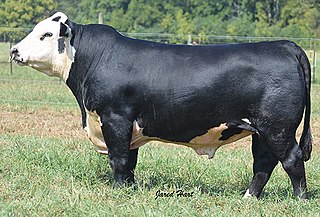
The Black Hereford is a beef cattle breed, derived mainly from Hereford cattle, but with some mixture from black Angus cattle, resulting in black cattle with a white head and finching.
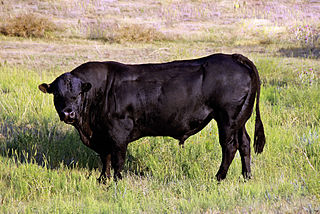
North American Piedmontese cattle are a breed of domestic beef cattle originating from an imported herd of select Italian purebred Piedmontese cattle. The foundation line of breeding stock was first imported from Italy into Canada in 1979, and into the United States in the early 1980s. Piedmontese cattle are distinguished by a unique, naturally occurring gene identified as the myostatin allele mutation, or inactive myostatin gene. Myostatin prohibits muscle growth whereas an inactive gene has the opposite effect. Purebred Piedmontese are homozygous,, which means they have two identical alleles present for this unique gene. Research indicates the presence of the myostatin allele mutation produces morphological characteristics unique to the breed, such as double-muscling, beef tenderness, reduced fat content and high yield. According to the North American Piedmontese Association (NAPA), they are the first breed registry to base animal registration requirements on the presence of this specific gene which can be easily verified by DNA testing.

Wairuna Homestead is a heritage-listed homestead at Wairuna Road, Wairuna, Tablelands Region, Queensland, Australia. It was built in 1940s by Harold and Norman Johnston. It is also known as Wairuna Station Homestead and Cemetery. It was added to the Queensland Heritage Register on 9 August 2013.

The Red Brangus is a breed of hybridised cattle developed to optimise the superior characteristics of Angus and Brahman Cattle. The breed's hybridisation stabilises at a ratio of 3/8 Brahman and 5/8 Angus. The breed is relatively new respectively, with the first breeding trial conducted in 1912 in Jeanerette, Louisiana, United States. of America.


















